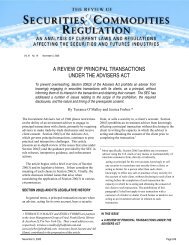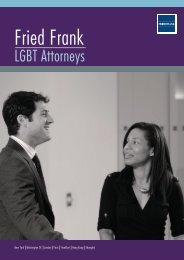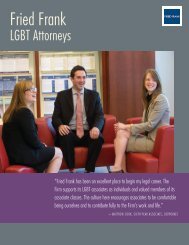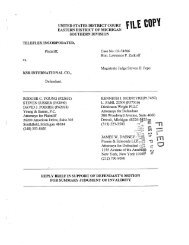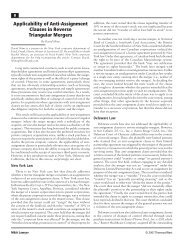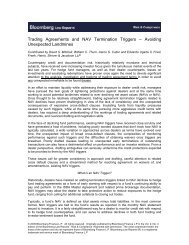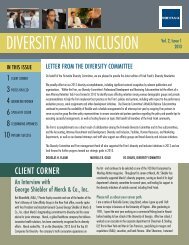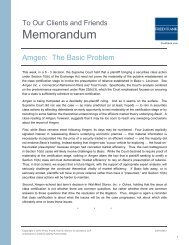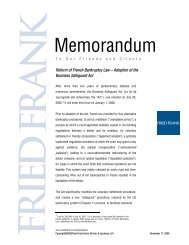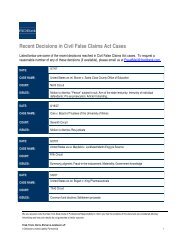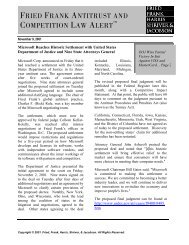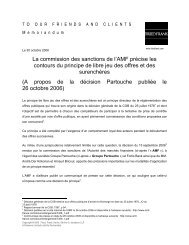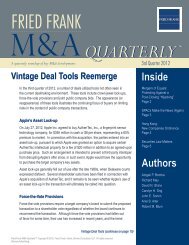CIVIL FALSE CLAIMS ACT: Eighth Circuit Rejects ... - Fried Frank
CIVIL FALSE CLAIMS ACT: Eighth Circuit Rejects ... - Fried Frank
CIVIL FALSE CLAIMS ACT: Eighth Circuit Rejects ... - Fried Frank
Create successful ePaper yourself
Turn your PDF publications into a flip-book with our unique Google optimized e-Paper software.
FraudMail Alert ®<br />
<strong>CIVIL</strong> <strong>FALSE</strong> <strong>CLAIMS</strong> <strong>ACT</strong>: <strong>Eighth</strong> <strong>Circuit</strong><br />
<strong>Rejects</strong> Justice Department Efforts to Avoid<br />
Paying Relators’ Share on Settlement<br />
“Unrelated” to Relators’ Qui Tam Claims<br />
The Justice Department (“DOJ”) received an unpleasant surprise last week. After releasing Hewlett-<br />
Packard Company (“HP”) from a range of False Claims Act liability in return for a $55 million settlement<br />
payment, a divided panel of the <strong>Eighth</strong> <strong>Circuit</strong> Court of Appeals ruled that DOJ would have to pay a<br />
substantial portion of that settlement amount to Relators—far beyond the limited “share” payment DOJ<br />
expected to make. United States ex rel. Roberts v. Accenture, LLP, No. 11-2054, 2013 WL 764734 (8th<br />
Cir. Mar. 1, 2013). The appellate decision rejected the government’s myriad arguments—including an<br />
unusual claim (for DOJ anyway) that Relators were not entitled to any recovery on certain qui tam<br />
complaint allegations because they lacked the particulars necessary to comply with Rule 9(b). The end<br />
result is that DOJ now has to pay Relators $8.8 million, as opposed to the $1.9 million it anticipated<br />
paying, leaving a $7 million deficit in the government’s net recovery in the case.<br />
While the <strong>Eighth</strong> <strong>Circuit</strong> ruling primarily addressed the fight between DOJ and Relators, with HP as<br />
bystander, the decision exposes the risk defendants face if they do not wrap up their attorneys’ fees<br />
liability at the time of settlement in cases where the relator’s share is still in dispute. A subsequent ruling<br />
that a relator is entitled to a share of the government’s recovery on “other” claims could lead to additional<br />
attorneys’ fees liability for the defendant under the FCA’s fee-shifting provision. 31 U.S.C. § 3730(d)(1) (a<br />
qui tam plaintiff “shall also receive an amount for reasonable expenses which the court finds to be have<br />
been necessarily incurred, plus reasonable attorneys’ fees and costs. All such expenses, fees and costs<br />
shall be awarded against the defendant”).<br />
Background<br />
In their qui tam complaint, filed in 2004, Relators alleged HP defrauded the government through certain<br />
kickback and defective pricing schemes. DOJ intervened in the action in 2006, after receiving what the<br />
<strong>Eighth</strong> <strong>Circuit</strong> described as extraordinary assistance from Relators, who not only funded substantial<br />
portions of the investigation but actually drafted the Inspector General subpoenas for the government<br />
attorneys. Two years after the intervention decision, HP disclosed the results of an internal audit,<br />
revealing compliance problems with respect to a price reduction clause under a specific GSA contract<br />
(“Contract 35F”). The qui tam complaint made no specific mention of Contract 35F. Ultimately, HP<br />
settled the claims with the United States for $55 million, of which $9 million expressly was allocated to the<br />
<strong>Fried</strong> <strong>Frank</strong> FraudMail Alert No. 13-03-08 03/08/2013<br />
Copyright © 2013 <strong>Fried</strong>, <strong>Frank</strong>, Harris, Shriver & Jacobson LLP. All rights reserved. Qui Tam practice group.
“kickback” allegations in the qui tam complaint and $46 million was allocated to the Contract 35F<br />
defective pricing claim. With respect to the Relators’ share payment, DOJ took the position that Relators<br />
were only entitled to a percentage of the $9 million payment for the kickback allegations, and that<br />
Relators would not be awarded any share of the $46 million recovery for the Contract 35F claim. Relators<br />
were not happy with this distribution and demanded their statutory share of the $46 million payment as<br />
well. The government’s refusal to share any portion of the Contract 35F recovery was litigated, resulting<br />
in the <strong>Eighth</strong> <strong>Circuit</strong> decision issued last week.<br />
The Role of the Government’s Intervention<br />
FCA Section 3730(d)(1) governs relator awards when the government intervenes in the qui tam action. It<br />
provides:<br />
If the Government proceeds with an action brought by a [relator], such person shall . . .<br />
receive at least 15 percent but not more than 25 percent of the proceeds of the action or<br />
settlement of the claim, depending upon the extent to which the person substantially<br />
contributed to the prosecution of the action.<br />
Relators argued that, in addition to their share of the $9 million settlement proceeds resulting from the<br />
kickback claim, they also should receive, under § 3730(d)(1), a 15 percent minimum share of the<br />
$46 million Contract 35F recovery as a “finder’s fee” for bringing the action in which the government<br />
intervened. DOJ had a different view of the situation. The government responded that “the proceeds of .<br />
. . [a] settlement of the claim” under § 3730(d)(1)—an action in which the government has intervened—<br />
are limited to the actual claims raised by the Relators, and do not include a claim (such as the Contract<br />
35F claim) that was not alleged in the Relators’ complaint and was not related to claims alleged in that<br />
complaint. Gov’t Reply Br. at 5-6. DOJ argued that its interpretation of this provision is consistent with<br />
the overall statutory scheme, which requires a claim-by-claim analysis to determine the relator’s right to<br />
share in the government’s recovery on a claim pursued through an alternate remedy and the relator’s<br />
right to recover as an “original source” of publicly disclosed allegations under the public disclosure bar.<br />
Gov’t Reply Br. at 7-11. See 31 U.S.C. § 3730(c)(5) (alternate remedy provision); 31 U.S.C. § 3730(e)(4)<br />
(public disclosure provision); Rockwell Int’l Corp. v. United States, 549 U.S. 457 (2007) (holding that<br />
relator was not an “original source” entitled to a share of government’s recovery under 31 U.S.C. §<br />
3730(e)(4) because relator’s allegations described an entirely different cause of the defective product<br />
fraud than that ultimately uncovered and settled by the government). And, as discussed below, DOJ<br />
argued that one of the ways that it could establish that the Contract 35F claim was unrelated to<br />
allegations in Relators’ complaint was that the “defective pricing” allegations in that complaint would not<br />
have satisfied the pleading requirements of Rule 9(b) and therefore were legally insufficient to state an<br />
FCA claim (which is a prerequisite to recovery by a relator).<br />
The <strong>Eighth</strong> <strong>Circuit</strong> applied a more limited interpretation of § 3730(d)(1), ruling that the 15 percent<br />
minimum share is a “minimum finder’s fee in situations where the government elects to proceed with a<br />
relator’s action and obtains a judgment or settlement” (subject to three statutory exceptions that did not<br />
apply in this case). 2013 WL 764734, at *5. On this rationale, the court upheld what it characterized as<br />
the district court’s “factual finding” that the settled Contract 35F claim was related to Relators’ action.<br />
Claim-by-Claim Analysis<br />
In its decision, the <strong>Eighth</strong> <strong>Circuit</strong> did not reject the concept that one way to ascertain whether claims are<br />
related for purposes of § 3730(d)(1) is to determine whether there is a factual overlap between them.<br />
<strong>Fried</strong> <strong>Frank</strong> FraudMail Alert ® No. 13-03-08 03/08/2013<br />
2
Instead, it held that the government had failed to identify any clear error in the district court’s<br />
determination that the Contract 35F claim was related to the qui tam claims. The court also focused on<br />
the timing of the Contract 35F claim, noting that since it was based on an HP disclosure made as part of<br />
an internal investigation that began shortly after a partial unsealing of the qui tam complaint, it was<br />
disingenuous for the government to claim it was an unrelated claim that stemmed from a purely voluntary<br />
disclosure by HP.<br />
This rationale drew criticism from the dissenting judge in Roberts, who pointed out that the key factual<br />
determination to be made is not when the government’s Contract 35F claim was made, but<br />
whether there is sufficient factual overlap between the defective pricing claim settled by<br />
the government and the claim brought by the relators, such that proceeds of the<br />
settlement of the defective pricing claim should fairly be characterized as “proceeds of<br />
the . . . settlement of the claim” brought by the relators.<br />
The dissent also criticized the majority for not undertaking its own review of the record in the case,<br />
suggesting strongly that such a review would have demonstrated that the claims were not related:<br />
although the court asserts in the end that the district court found that the relators brought<br />
the same claim that the government settled, the court never reviews whether such a<br />
finding is supported by the record. The court affirms the district court's award based on a<br />
different theory—that is, that the relators' action played a role in uncovering the defective<br />
pricing scheme that was the subject of the government's settlement. Ante, at 10. But as<br />
discussed, the court's theory is legally flawed, because the statute does not give relators<br />
the right to a share of recovery based on additional claims that the government brings or<br />
settles after it intervenes in an action to pursue a claim or claims brought by relators.<br />
The dissent is persuasive. Related precedent and the actual language of § 3730(d)(1) support the view<br />
that an issue discovered and disclosed after certain allegations are made is not necessarily sufficiently<br />
factually related to those original allegations by the relator to trigger the statutory “finder’s fee.” The<br />
majority decision’s focus on timing, on the other hand, would seem to allow this fee for all claims that<br />
would not have been asserted by the government but for the Relators’ original complaint, no matter how<br />
factually attenuated. See 2013 WL 764734, at *7 (“The FCA’s purpose was advanced in this case. The<br />
relators’ complaint and assistance in prosecuting the action resulted in HP investigating its pricing<br />
practices. The government then chose to intervene in the relators’ action, initiated its own investigation<br />
into HP’s defective pricing, and ultimately reached a settlement favorable to the government. Thus, the<br />
relators’ action served its intended purpose, and the relators should be rewarded accordingly.”).<br />
Rule 9(b) Analysis<br />
In somewhat of a role reversal for DOJ, the government sought to bolster its argument that the Contract<br />
35F claim was not related to the qui tam complaint allegations by applying a Rule 9(b) analysis. The<br />
government argued strenuously that (a) Rule 9(b) applies to FCA claims, (b) the allegations in the qui tam<br />
complaint should be evaluated under a 9(b) standard to determine if they are sufficiently pleaded, and<br />
(c) the complaint allegations are devoid of the details and particulars that are essential to pleading an<br />
FCA cause of action. DOJ’s acknowledgement of the importance of Rule 9(b) in weeding out FCA<br />
allegations that are based on conclusory assertions and speculation certainly is welcome and refreshing,<br />
particularly given its express recognition in its appellate brief of the type of pleading that is mandatory to<br />
meet the Rule 9(b) standard:<br />
<strong>Fried</strong> <strong>Frank</strong> FraudMail Alert ® No. 13-03-08 03/08/2013<br />
3
The Rule requires any fraud claim to specify “the time, place, and content of the<br />
defendant’s false representations, as well as the details of the defendant’s fraudulent<br />
acts, including when the acts occurred, who engaged in them, and what was obtained as<br />
a result.”<br />
[ . . . . ]<br />
But as this Court [has] . . . made clear, while the requirements of Rule 9(b) must be read<br />
in harmony with the principles of notice pleading, a fraud claim still “must identify who,<br />
what, where, when, and how.”<br />
[ . . . . ]<br />
A qui tam complaint that fails to meet Rule 9(b)’s specificity requirements is a “legally<br />
invalid complaint” that “cannot form the basis for recovery” under the FCA.<br />
Gov’t Reply Br. at 17-19.<br />
The <strong>Eighth</strong> <strong>Circuit</strong> panel reaffirmed the importance of Rule 9(b) and its role as a safeguard that protects<br />
defendants from frivolous accusations and provides notice of the claims against them. But the court<br />
rejected the government’s theory that Rule 9(b), which is “meant to test the sufficiency of a complaint at<br />
its outset,” has any bearing on a relator’s share determination under § 3730(d)(1) at the end of the case<br />
when there is no longer any opportunity to cure a deficiency. 1<br />
The Court therefore affirmed the district court’s determination that Relators were entitled to both a 21<br />
percent recovery on the $9 million kickback claim (which was not in dispute on appeal) and also a 15<br />
percent recovery on the $46 million recovery on the Contract 35F defective pricing claim. The end result<br />
is that DOJ had to pay out to the Relators $7 million more than it anticipated when it settled the matter<br />
with HP.<br />
Also, as a practical matter, the <strong>Eighth</strong> <strong>Circuit</strong>’s ruling underscores the importance of resolving relator’s<br />
share and attorneys’ fee issues at settlement in intervened cases. In particular, if attorneys’ fees liability<br />
is not resolved at settlement, particularly where there is an unresolved dispute between the relator and<br />
the government over the relator’s share payment, the defendant may end up being responsible for<br />
additional attorneys’ fees liability. It should be noted that attorneys’ fees liability also can be created in<br />
other settings where a qui tam action has been filed, including cases where the government has resolved<br />
the matter through an alternate remedy or contract modifications. See, e.g., United States ex rel. Barajas<br />
v. Northrop Corp., 258 F.3d 1004 (9th Cir. 2001) (ruling that, under the circumstances of the case,<br />
suspension and debarment proceeding was an alternate remedy); United States ex rel. Alderson v.<br />
1<br />
The court also examined cases cited by the government and found that they did nothing to advance the<br />
government’s argument. 2013 WL 764734, at *9-10. Specifically, the court distinguished the Sixth <strong>Circuit</strong>’s<br />
decision in United States ex rel. Bledsoe v. Community Health Systems, 501 F.3d 493 (6th Cir. 2007) (“Bledsoe<br />
II”) as an “alternate remedy” case in which the government began its investigation before the relator filed the qui<br />
tam suit, it did not intervene in the qui tam action, and the relator failed to establish a connection between his<br />
action and the government’s existing settlement. Also, the court determined that the Supreme Court’s decision<br />
in Rockwell International Corp. v. United States, 549 U.S. 457 (2007) did not apply because relator’s action in<br />
that case was challenged as based on publicly disclosed allegations and the Supreme Court ruled that the relator<br />
was not an “original source,” but the government in Roberts did not challenge Relators’ claim under the “direct<br />
and independent” standard of the original source provision.<br />
<strong>Fried</strong> <strong>Frank</strong> FraudMail Alert ® No. 13-03-08 03/08/2013<br />
4
Quorum Health Group, Inc., 171 F. Supp. 2d 1323, 1339-40 (M.D. Fla. 2001) (“Any exclusion of the $5<br />
million should have been manifested in the language of the settlement agreement”).<br />
* * *<br />
This memorandum is not intended to provide legal advice, and no legal or business decision should be<br />
based on its content. If you have any questions about the contents of this memorandum, please call your<br />
regular <strong>Fried</strong> <strong>Frank</strong> contact or one of the attorneys listed below:<br />
Author:<br />
Douglas W. Baruch<br />
Contacts:<br />
Douglas W. Baruch<br />
Partner<br />
+1.202.639.7052<br />
John T. Boese<br />
Of Counsel<br />
+1.202.639.7220<br />
<strong>Fried</strong> <strong>Frank</strong> FraudMail Alert ® No. 13-03-08 03/08/2013<br />
5
New York<br />
One New York Plaza<br />
New York, NY 10004<br />
Tel: +1.212.859.8000<br />
Fax: +1.212.859.4000<br />
Washington, DC<br />
801 17th Street, NW<br />
Washington, DC 20006<br />
Tel: +1.202.639.7000<br />
Fax: +1.202.639.7003<br />
London<br />
99 City Road<br />
London EC1Y 1AX<br />
Tel: +44.20.7972.9600<br />
Fax: +44.20.7972.9602<br />
Paris<br />
65-67, avenue des Champs Elysées<br />
75008 Paris<br />
Tel: +33.140.62.22.00<br />
Fax: +33.140.62.22.29<br />
<strong>Frank</strong>furt<br />
Taunusanlage 18<br />
60325 <strong>Frank</strong>furt am Main<br />
Tel: +49.69.870.030.00<br />
Fax: +49.69.870.030.555<br />
Hong Kong<br />
1601, Chater House<br />
8 Connaught Road Central<br />
Hong Kong<br />
Tel: +852.3760.3600<br />
Fax: +852.3760.3611<br />
Shanghai<br />
Unit 537, East Wing,<br />
Shanghai Centre<br />
1376 Nanjing Road West<br />
Shanghai 200040, PRC<br />
Tel: +86.21.6289.8962<br />
Fax: +86.21.6289.8963<br />
A Delaware Limited Liability Partnership<br />
FraudMail Alert® is published by the Qui Tam Practice Group of, and is a registered trademark and servicemark of <strong>Fried</strong>, <strong>Frank</strong>, Harris,<br />
Shriver & Jacobson LLP.<br />
FraudMail Alert® is provided free of charge to subscribers. If you would like to subscribe to this E-mail service, please send an E-mail<br />
message to FraudMail@friedfrank.com and include your name, title, organization or company, mail address, telephone and fax numbers, and<br />
E-mail address.<br />
To view copies of previous FraudMail Alerts, please visit our FraudMail Alert® archives on the <strong>Fried</strong> <strong>Frank</strong> website.<br />
To view copies of previous Qui tam To Our Client Memoranda, please visit our archives on the <strong>Fried</strong> <strong>Frank</strong> website.<br />
To unsubscribe from all <strong>Fried</strong> <strong>Frank</strong> Email Alerts and electronic mailings send a blank email to unsubscribe@friedfrank.com<br />
<strong>Fried</strong> <strong>Frank</strong> FraudMail Alert ® No. 13-03-08 03/08/2013<br />
6



